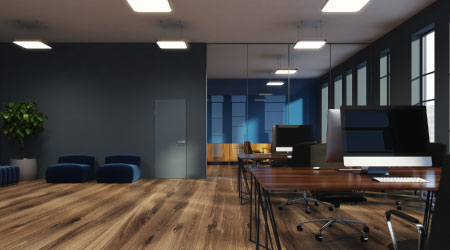Carpet Tile Highly Engineered Floor Covering
Carpet tile is the most highly engineered textile floor covering material. Its use has exploded and continues to grow. It possesses many positive attributes, not the least of which is ease of transportation and installation in high-rise buildings.
Many managers believe its most positive feature is the ease of replacing a tile due to damage or spills. Taking up one tile and replacing it is easy, but the new tile might not blend in, due to such factors as soiling, color change, and traffic.
Carpet-tile backing can be made from polyvinyl chloride (PVC), polyester, polypropylene, polyurethane and other materials. Many of these backings contain recycled content, such as plastic bottles, windshield liners and recycled fiber. One challenge the industry has faced with the changes in backing technology and materials is ensuring tiles remain flat. Curling issues have been pervasive and frustrating.
As with any new technology, manufacturers and customers must go through a learning curve. Out of the box, the carpet tile must be flat, square and stable. Adhesive is not supposed to hold carpet tile flat on the floor; the tile should do that on its own. The adhesive keeps carpet tile from moving laterally.
For the most part, installation technology and carpet tiles go hand in hand. But carpet tiles are not the only products affected by recent advances. Installation using an adhesive in a bucket is losing favor because of sustainability concerns. In addition, issues such as substrate conditions, incorrect application, failure due to contaminants, cheap adhesives and environmental conditions also can compromise the use of a separate adhesive.
As a result of these issues, alternative systems have been developed from Velcro squares to adhesive squares and applied bonding agents and mechanical locking or click systems. One system designed to thwart the effects of moisture and alkalinity is an applied polyacrylic adhesive that can be applied to any hard-back flooring material. Another system uses magnetism as an installation method.
Spotlight On Recycling
The flooring industry has made a concerted effort to manufacture products that have a smaller impact on the environment. Some carpet products can be recycled, while other products can be converted to energy. Also, many flooring products use recycled content. Some flooring products can be turned into other products, such as automobile engine compartment components, bumper stops, and outdoor furniture.
The industry — particularly carpet manufacturers — have been extremely involved and ahead of the curve for several years in recycling efforts. But the best way for managers to be environmentally conscious is to make sure they select the best flooring products, properly install and maintain them, and provide a controlled environment so that they do not prematurely fail.
Lewis G. Migliore is president of LGM & Associates and has been associated with the floor covering industry for the past 40 years.
Related Topics:














